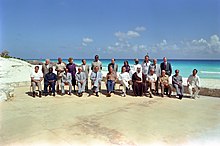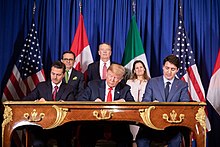Canada–Mexico relations
 | |
Canada |
Mexico |
|---|---|
| Diplomatic mission | |
| Embassy of Canada, Mexico City | Embassy of Mexico, Ottawa |
Canada–Mexico relations are relations between Canada and the United Mexican States. Although historic ties between the two nations have been dormant, relations between Canada and Mexico have positively changed in recent years, seeing as both countries brokered the NAFTA. They were on different sides of the Cold War Spectrum (Canada was a member of NATO while Mexico was in the Non-Aligned Movement, though Mexico later left; the two countries were, however, allies in World War II).
Both nations are members of the Asia-Pacific Economic Cooperation, G-20 major economies, Lima Group, Organization of American States, Organisation for Economic Co-operation and Development and the United Nations.
History[]

Before Canada became an independent nation, there had been previous contacts between Canada and Mexico in the 1800s. Canadian made products were sold in Mexico under British companies' logos.[1] Since gaining independence from the United Kingdom in 1867; Canada delayed in establishing diplomatic relations with Mexico due to the expropriation of foreign oil companies in 1938. At the time, Canada felt obliged to follow other nations in isolating Mexico economically and diplomatically. Formal relations between the two nations did not begin until 30 January 1944, at the height of Second World War, which both countries participated in on the Allied side. In 1952, Mexico opened its first consulate-general in Montreal.[1]
The first ever meeting between leaders of both nations took place in White Sulphur Springs, West Virginia in 1956 between Mexican President Adolfo Ruiz Cortines, Canadian Prime Minister Louis St. Laurent and American President Dwight D. Eisenhower.[1] In 1959, President Adolfo López Mateos chose to visit Canada on his first official visit abroad. The visit was reciprocated by Prime Minister John Diefenbaker in 1960. Since then, almost every Mexican President has visited Canada at least once and almost every Canadian Prime Minister has visited Mexico.
In 1968, a joint ministerial commission was set up by both nations to meet every two years to discuss and analyze mutual interests in promoting development and deepening bilateral relations. In 1974, an agreement was signed between both nations to allow temporary migrant workers from Mexico to work in Canada.[1]
NAFTA and since[]


In 1990, leaders of Canada, Mexico and the United States began negotiating a free trade agreement that would be known as the North American Free Trade Agreement (NAFTA). Canada had just signed a free trade agreement with the United States in 1988 (FTA) when the US, under President George H. W. Bush, began to negotiate another pact with Mexico under President Carlos Salinas de Gortari. The Canadian government under Prime Minister Brian Mulroney feared that the advantages Canada had through the Canada-US FTA would be undermined, and asked to become a party to the US-Mexican talks.[2] The result was that NAFTA replaced the previous Canada-US FTA. An agreement was reached between all three nations and NAFTA came into effect on 1 January 1994.[1] Since NAFTA has come into force, the two countries have become much more important to each other, and often collaborate when dealing with the United States.
Relations between the two governments were particularly strong during the first decade of the twenty-first century. In October 2006, then President-elect Felipe Calderón visited Ottawa, and Prime Minister Stephen Harper attended the inauguration of President Calderón. The two leaders were ideological allies, both being pro-market conservatives, Calderón of the National Action Party and Harper of the Conservative Party.
In November 2012, President-elect Enrique Peña Nieto also chose to visit Ottawa as a president-elect before taking the presidential oath. In an editorial in The Globe and Mail on that occasion Peña Nieto characterized the relationship before 1994 as one of "mutual benign neglect" but praised the increase in trade and travel between the two countries since NAFTA. He called for increased Canadian foreign direct investment in Mexico, especially in the petroleum industry, though he said that Petróleos Mexicanos, the state oil company, would remain the owner of the resources. As well he called "North American energy security" a "common goal" of both countries. He also pledged to work to reduce drug-related violence in the country and protect visiting Canadians. He also asked Canadians to reconsider a 2009 decision requiring Mexicans to have visas before coming to Canada.[3]
On December 1, 2016, Canada lifted the visa requirement for Mexican citizens.[4] On 30 November 2018, President Enrique Peña Nieto, Prime Minister Justin Trudeau and U.S. President Donald Trump signed the United States–Mexico–Canada Agreement during the G20 summit in Buenos Aires, Argentina. This agreement, if ratified by all three nations, is expected to replace NAFTA. In December 2018, Governor General Julie Payette attended the inauguration of President Andrés Manuel López Obrador.[5]
High-level visits[]
High-level visits from Canada to Mexico
- Prime Minister John Diefenbaker (1960)
- Prime Minister Pierre Trudeau (1974, 1976, 1981, 1982)
- Prime Minister Brian Mulroney (1990)
- Prime Minister Jean Chrétien (1994, 1999, 2002, 2003)
- Prime Minister Paul Martin (2004)
- Prime Minister Stephen Harper (2006, 2009, 2012, 2014)
- Governor General Michaëlle Jean (2009, 2010)
- Prime Minister Justin Trudeau (2017)
- Governor General Julie Payette (2018)
High-level visits from Mexico to Canada

- President Adolfo López Mateos (1959)
- President Luis Echeverría Álvarez (1973)
- President José López Portillo (1980)
- President Miguel de la Madrid Hurtado (1984)
- President Ernesto Zedillo (1996, 1997, 1999)
- President Vicente Fox (2001, 2005)
- President Felipe Calderón (2007, May & June 2010)
- President Enrique Peña Nieto (2016)
Bilateral agreements[]
Both nations have signed several bilateral agreements such as an Agreement on Air Transportation; Agreement on Postal Mail Exchange; Agreement on Cultural Cooperation; Treaty on the Execution of Criminal Judgments; Agreement of Environmental Cooperation; Agreement on Tourist Cooperation; Agreement on Mutual Legal Assistance Cooperation in Criminal Matters; Extradition Treaty; Agreement on Mutual Assistance and Cooperation in Customs Administrations; Agreement of Cinematographic and Audiovisual Co-production; Agreement on Cooperation in the Areas of Museums and Archaeology; Agreement for Cooperation in the Peaceful uses of Nuclear Energy; Agreement on Social Security; Agreement on Satellite Services; and an Agreement on Competition Laws; Agreement on the Avoidance of Double Taxation and Prevent Tax Evasion on Income.[6]
Trade[]
Twenty years after NAFTA, Mexico became the largest exporter and importer in Latin America. It exports more manufactured goods than all other Latin American countries combined. The country remains highly dependent on exports to the U.S., but it is on a path toward diversification.[citation needed] In 2018, two-way trade between both nations amounted to US$22.8 billion.[7] Canada's main exports to Mexico include: seeds; aluminum alloys; wheat; vehicle and vehicle parts and accessories; diesel fuel and diesel oil and mixtures; goods for the assembly or manufacture of aircraft and airplanes (among others). Mexico's main exports to Canada include: vehicles (both passenger and transport); flat screen TVs; goods for the assembly or manufacture of aircraft and parts; piston engines parts; tractors; electronics for receiving, converting and transmitting voice feedback; and avocados (among others).[6]
In 2017, Canadian companies invested US$2.7 billion and is the third largest foreign investor in Mexico (behind the United States and Spain).[6] Canadian multinational companies such as Bombardier Inc., BlackBerry, Fairmont Hotels and Resorts and Scotiabank operate in Mexico. At the same time, Mexican multinational companies such as Cemex and Grupo Bimbo operate in Canada. Various Mexican beer and tequila products are sold in Canada.
Diplomatic missions[]
|
|

Embassy of Canada in Mexico City

Building hosting the Embassy of Mexico in Ottawa
See also[]
- Canada–Latin America relations
- Canadian Mexicans
- Mexican Canadians
- North American Leaders' Summit
- Seasonal Agricultural Workers Program
References[]
- ^ Jump up to: a b c d e History of diplomatic relations between Mexico and Canada (in Spanish)
- ^ Foreign Affairs and International trade Canada: Canada and the World: A History - 1984-1993: "Leap of Faith Archived 2007-10-27 at the Wayback Machine
- ^ "For Mexico and Canada, there's room to grow". The Globe and Mail. Archived from the original on 3 February 2013. Retrieved 28 April 2016.
- ^ "Canada to lift visa requirements for Mexico". Prime Minister of Canada. 2016-06-28. Retrieved 2016-12-18.
- ^ Governor General of Canada to visit Mexico for presidential inauguration
- ^ Jump up to: a b c Bilateral agreements between Mexico and Canada (in Spanish)
- ^ "Mexican Ministry of the Economy: Canada (in Spanish)". Archived from the original on 2019-07-28. Retrieved 2018-03-14.
- ^ Embassy of Canada in Mexico City
- ^ Consulate-General of Canada in Monterrey
- ^ Consulate of Canada in Guadalajara
- ^ Embassy of Mexico in Ottawa
- ^ Consulate-General of Mexico in Montreal
- ^ Consulate-General of Mexico in Toronto
- ^ Consulate-General of Mexico in Vancouver
- ^ Consulate of Mexico in Calgary
- ^ Consulate of Mexico in Leamington
- Canada–Mexico relations
- Bilateral relations of Canada
- Bilateral relations of Mexico


